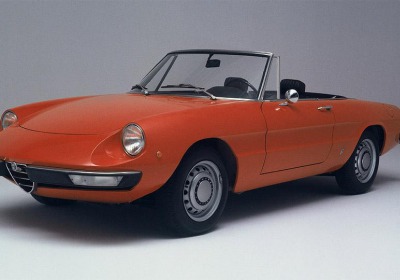The original red dream turns 100: Alfa Romeo celebrates its centenary
Thu, 24 Jun 2010
It hasn't been sold in the United States for the better part of two decades. Its last Grand Prix victory was in the early 1950s. The reliability of some of its cars can be charitably defined as iffy. But it has a history second to none.
Today, Italian automaker Alfa Romeo celebrates its 100th anniversary. The original red dream began on June 24, 1910, and festivities to mark the occasion will stretch through the weekend in Milano.
So what is it about Alfa that conjures up such magic and memories? Alfa is a microcosm of why enthusiasts like cars. It doesn't have to be rational. It's fun and it's elusive, exciting and invigorating. And it's simply about the automobile. Money and maintenance aren't part of the discussion.
Alfisti know most of this, but here's a short version of some memorable moments in the history of the brand.
The company was founded in 1910, and the first car to wear the famous badge was the 24 HP. The name, originally A.L.F.A., stands for Anonima Lombarda Fabbrica Automobili (which means Lombard Automobile Factory, Public Company). A.L.F.A. was bought by Neapolitan engineer and businessman Nicola Romeo in 1915, and the Alfa Romeo moniker was born.
The company truly found its legs in the 1920s and '30s, as the age of the automobile grew rapidly around the world. The 8C 2300 from the early '30s took the world by storm with its supercharged eight-cylinder inline engine, and 8Cs remain a favorite at summer concours.
An Alfa won Targa Florio in 1923, helping to launch the long racing lineage of Italian cars. The brand counts 10 victories at Targa--second only to Porsche--and Alfa won the Mille Miglia a record 11 times. Overshadowed by the unparalleled racing history of a company it helped begat--Ferrari--Alfa does, in fact, count two world championships in Grand Prix racing. Despite withdrawing from Formula One in the 1950s, its two titles equal Renault and Mercedes. Antonio Ascari, the father of Ferrari champion Alberto Ascari, and Enzo Ferrari drove for Alfa.
Twice the company mobilized to support Italian efforts in world wars and its factories were converted for wartime production. Alfa plants were bombed during World War II.
Alfa Romeo
The Alfa Romeo Spider appealed to open-air thrill-seekers.
As Italy rebuilt, the company emerged for a golden age in the 1950s and '60s with the Guiletta and then the Giulia. The marque was cemented in pop culture when Dustin Hoffman famously drove a spider in the 1967 classic The Graduate. Over the years, Alfa also collaborated extensively with Milanese body maker Zagato and design house Pininfarina, themselves both icons of Italian carmaking.
Despite Hollywood magic, Alfa would ultimately struggle in the United States, and it withdrew in 1995 amid declining sales and reliability questions. The most memorable Alfas endure for their sexy sheetmetal and driving dynamics, though the company was never a threat to Detroit's Big Three.
Fiat bought Alfa in 1986. Its recent history has been decidedly less glamorous, but there have been highlights and signs of life. Car fans did get a (high-priced) taste of Alfa again, when the 8C Competizione made it to U.S. shores in coupe and spider forms. But it was extremely limited; just 50 coupes and 35 open-tops arrived. The MiTo was revealed in 2008, and just this winter, the new Giulietta broke cover at the Geneva motor show, offering fans the tantalizing potential for more.
With this as a foundation, Alfa followers are left to ponder what lies ahead.
GREG MIGLIORE
The modern Giulietta was revealed at the Geneva motor show.
As the Fiat conglomerate now stewards Chrysler, Alfa is poised to return to U.S. shores in the next few years, using the parent company's resources as a touchstone. With its present more secure than ever, perhaps Alfisti can look to the future with a ray--illuminated in red--of hope.
By Greg Migliore

